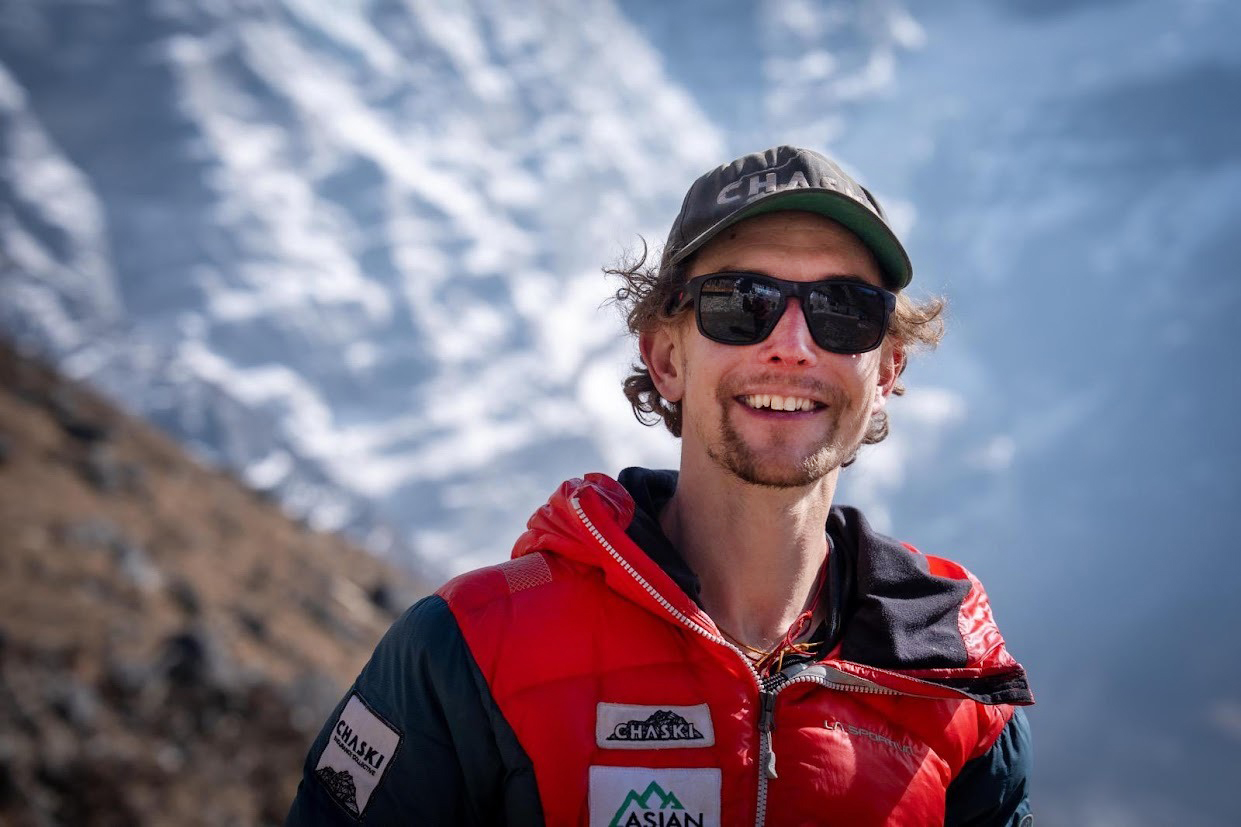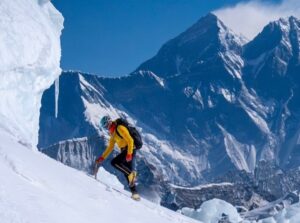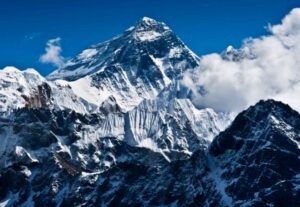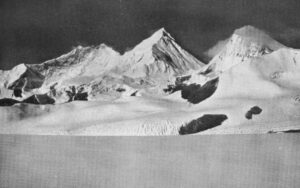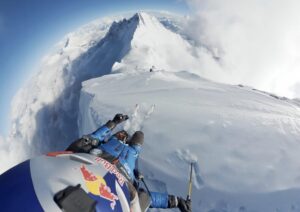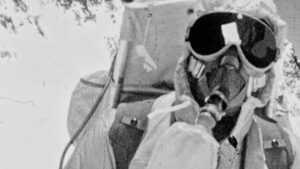Last week, ultrarunner Tyler Andrews launched a last-ditch attempt to achieve the fastest-ever no-oxygen climb on Everest. It was his third try, just three days after a previous one, and with the mountain about to close. After hours without communication and his live tracker apparently not moving, his team shared the news: Tyler had turned around at 8,450m.
Now somewhat recovered from an exhaustion he says he has never before experienced, Andrews explained to us what many were wondering: What happened up there?
Why the second, windy attempt
Before getting into what happened on May 27 on Everest, let’s first make sense of why he went up on May 23-24, despite high winds raking the mountain. Andrews, 35, said his reason was the same that prompted Karl Egloff, also pursuing an Everest FKT (Fastest Known Time), to start his own run just a couple of hours before Andrews. The Icefall Doctors wanted to close the route on May 25.
“They said the Icefall was moving too fast, there had been some collapses, and it was not safe,” says Andrews. He believed his only option was to go up or go home.
Andrews left Everest Base Camp on May 23 at around 8 pm local time. For safety, he started using supplementary oxygen at Camp 2.
“Meteorologists, doctors, my expedition leader, they all told me: Do not go up without oxygen, it is too cold, too windy, you will not reach the summit, and you will lose fingers and toes.”
That same day, Karl Egloff of Ecuador started his own record attempt, without supplementary oxygen. Egloff turned around shortly after Camp 3.
For Andrews, too, the wind ultimately ruled the day. Shortly after Camp 4, his expedition leader, Dawa Steven Sherpa, made the call to abort Tyler’s attempt and withdraw all his team from the mountain because of the high winds on the upper sections.
Tyler descended to Base Camp during the night of May 24 and flew to Kathmandu the following day. When he hopped on the helicopter, he was sure there would be no more opportunities. But back in Kathmandu, something unexpected happened.
“We learned that the big Indian Army team had failed on their summit push on May 23, also due to high winds,” explained Andrews. “Because of their influence, [the Icefall Doctors would keep] the mountain open three or four days more.”

Everest Base Camp. Photo: Tyler Andrews
Snap decision
I didn’t feel like I had left all I had on the [previous] attempt, so when I returned to Kathmandu, I had a good night of sleep and woke up the next morning to hear that the Indian team was going on the 27th in good weather. I immediately started thinking that another attempt was feasible and after a whole bunch of phone calls to Dawa, my family, and my team…we decided, well, ok, let’s give it a go!
Andrews flew back to Everest Base Camp and set off that same night, May 26, on a no-oxygen run toward the summit of Everest. Unlike Andrews, Karl Egloff decided not to try again and went home.

Tyler Andrews leaves Everest Base Camp on his first FKT attempt. Photo: Tyler Andrews/Instagram
Disaster at 8,000m
“[On the final attempt,] everything went quite well until Camp 4,” Andrews explained.
He admits that his pace slowed between Camp 3 and Camp 4, because on this last-minute attempt, he had less support and had to carry a much heavier backpack containing his high-altitude equipment. Instead of crew members at all the camps, as on his previous tries, on May 27, he had a support team at Camp 4 for emergencies, but otherwise, he was alone. That slowed him down a little, but otherwise had no bearing on his final decision.
Rather, something went wrong just after leaving Camp 4 (7,950m), some twelve-and-a-half hours after departure.
“I had one of my gels and vomited it immediately, which is something that had never happened to me before. Maybe it was the altitude or exhaustion, but probably I should have returned to camp and tried to eat something else.”
But Andrews chose to continue up, and soon he became unable to manage his remaining energy. “On all ultra-marathons, losing the last two hours of nutritional income means you’re in big trouble,” he explained.

Camp 4 at nearly 8,000m on Everest. Photo: Tyler Andrews
“Honestly, when I left Camp 4, I was sure there was no way I was not making the record,” Andrews said. “In the worst-case scenario, getting to the top would take me seven to eight hours, and that would still be under the record. But it was just so much slower than that.”
Faces on the snow
“I ran out of gas, I was totally fried up there,” he admits. “Also, at that point, I had lost communication, so it was a very lonely stretch. I was above the Balcony when I realized I was not going to reach the summit that day, and I didn’t even have contact with Base Camp.”
Still, he hesitated, but hallucinations finally convinced him to retreat.
What really decided me to make the call was that I started having hallucinations from fatigue. I would look at the snow and see geometrical shapes and faces, stuff like that. I knew these things were not there but I still could see them, and that was pretty alarming.
In addition, the route above the Balcony is technical and exposed. I had never been there before and I was totally on my own, with no one on the mountain. I decided I couldn’t have the record safely in that state, and my priorities are getting the record AND getting back down safely; both things equally important.
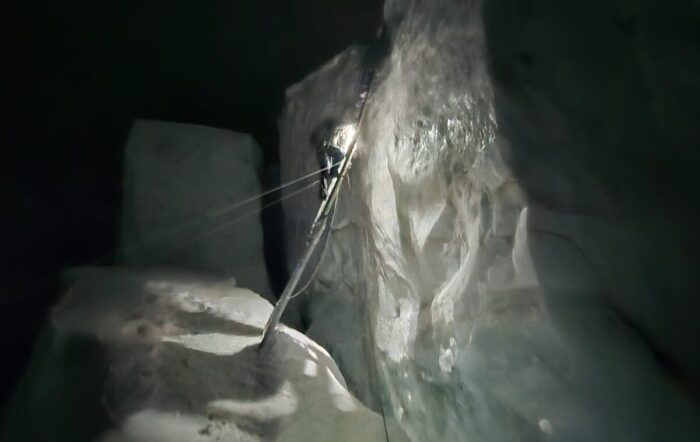
Chris Fisher climbs a ladder in the Khumbu Icefall during Andrews’ first attempt. Photo: Tyler Andrews
Andrews then turned around and made his long way back to Camp 4. Here, he rested and then continued down in order to cross the Icefall and reach Base Camp the following night.
No external pressure
Andrews denies he felt under any external pressure to bag the record.
“If anything, some people suggested I shouldn’t do the last attempt. All the pressure came from myself. I really, really wanted to do it.”
As for the physical strain of the two previous attempts, Andrews said he usually recovers quickly from intense efforts. He also felt that he had not used all his energy during the second attempt because the push was halted before he reached the summit.
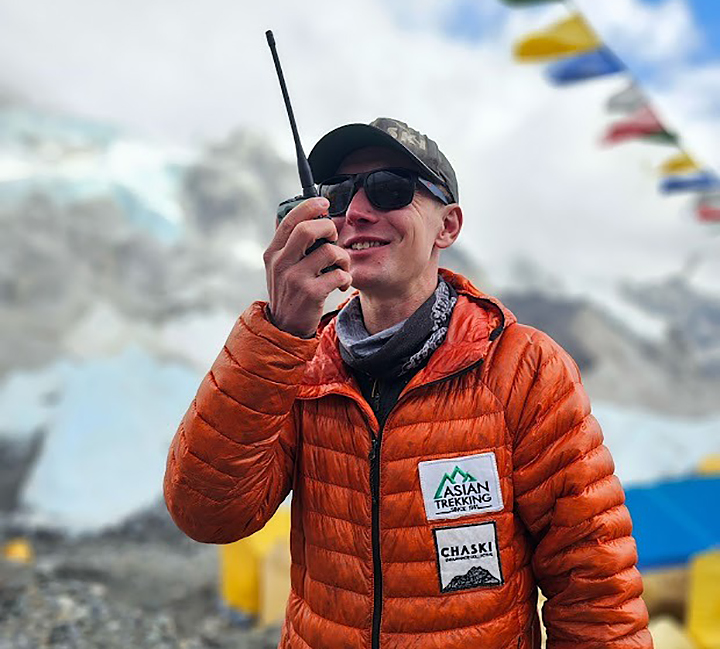
Tyler Andrews speaks on the radio at Everest Base Camp. Photo: Team Tyler Andrews
While Andrews and Karl Egloff have avoided commenting on each other, their May 23 attempt to run up Everest highlighted this as a race between two contenders. However, Andrews refuses to look at the challenge that way.
Honestly, I never saw this as a competition; I knew Karl [Egloff] was there, I knew he had his own team and was attempting a similar FKT, but I had to keep focused on myself and my team. You can’t control what others do. It is not different from a marathon, in which you’re obviously not the only participant, but the best way to go is just try to run your best race.
Same place next year?
After the impressive but heartbreaking effort, does Andrews want to try again in the future?
“If I can make it work financially, I will definitely be back,” he replied. “It is a huge cost in terms of money, energy, and time, but it’s an important project for me. I am 100% sure I am capable of it.”

Tyler Andrews in very light clothes for Everest. Photo: Tam Tyler Andrews
Indeed, Everest is far from becoming cheaper or less commercial. Yet Andrews admits it is a very special place.
“I still feel that the Khumbu Valley and these mountains, which are the tallest on Earth, are very, very special. That said, there are an awful lot of people there, some of whom show less respect to the mountain and nature than I’d like to see. But I think most are there because they want to push themselves and experience being in such a unique place. To me, watching others strive tremendously hard for something they care about is super meaningful.”
